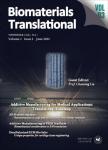Update on the research and development of magnesium-based biodegradable implants and their clinical translation in orthopaedics
作者机构:School of Biomedical EngineeringSun Yat-sen UniversityGuangzhouGuangdong ProvinceChina Hanglok-Tech Co.Ltd.ZhuhaiGuangdong ProvinceChina Musculoskeletal Research Laboratory of Department of Orthopaedics&Traumatology and The Chinese University of Hong Kong Shenzhen-Hong Kong Innovation and Technology Institute(Futian)The Chinese University of Hong KongHong Kong Special Administrative RegionChina
出 版 物:《Biomaterials Translational》 (生物材料转化电子杂志(英文))
年 卷 期:2021年第2卷第3期
页 面:188-196页
学科分类:08[工学] 080502[工学-材料学] 0805[工学-材料科学与工程(可授工学、理学学位)]
基 金:supported by Guangdong Natural Science Fund of China(No.2019A1515011404) Key-Area Research and Development Program of Guangdong Province of China(No.2020B090924004) Area of Excellences Scheme of Hong Kong Research Grants Council of China(No.AoE/M-402/20)
主 题:ACL reconstruction clinical translation fracture model magnesium orthopaedic implants
摘 要:Biodegradable magnesium(Mg)or its alloys are desirable materials for development into new-generation internal fixation devices or implants with high biocompatibility,adequate mechanical modulus,and osteopromotive properties,which may overcome some of the drawbacks of the existing permanent orthopaedic implants with regard to stress-shielding of bone and beam-hardening effects on radiographic *** review summarises the current research status of Mg-based orthopaedic implants in animals and clinical ***,detailed information of animal studies including bone fracture repair and anterior cruciate ligament reconstruction with the use of Mg-based orthopaedic devices is ***,the repair mechanisms of the Mg-based orthopaedic implants are also ***,reports of recent clinical cases treated using Mg-based implants in orthopaedics are ***,the challenges and the strategies of the use of Mg-based orthopaedic implants are *** together,the collected efforts in basic research,translational work,and clinical applications of Mg-based orthopaedic implants over the last decades greatly contribute to the development of a new generation of biodegradable metals used for the design of innovative implants for better treatment of orthopaedic conditions in patients with challenging skeletal disorders or injuries.



